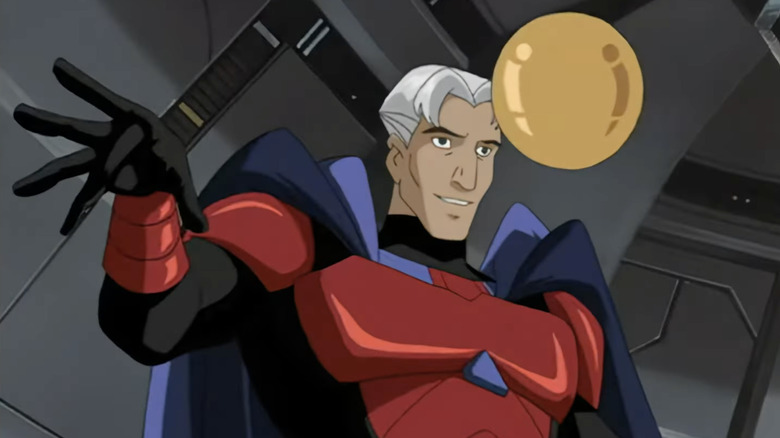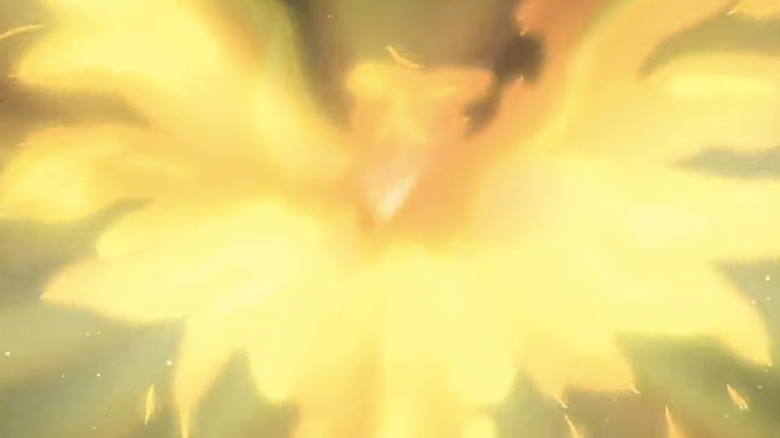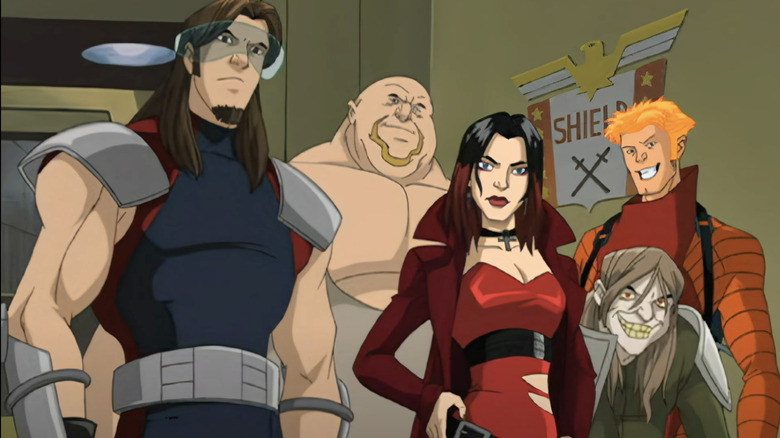The X-Men: Evolution Finale Explained: A Peek Into Comic History
The finale of "X-Men: Evolution" — titled "Ascension" — is mostly a triumphant one. The eponymous team successfully defeats En Sabah Nur/Apocalypse, sending the villain spiraling through the limbo of time. In the process, they stop his plan to turn all of mankind into mutants (and kill those who can't "ascend" in the process) and rescue Apocalypse's brainwashed Horsemen (Professor X, Storm, Magneto, and Mystique). Left without their mentor in their darkest hour, the teenage X-Men prove themselves more than mere students: true heroes.
The creators had plans for more before "Evolution" was canceled, and the closing moments reflect that. Professor X reveals that he glimpsed their shared futures in the mind of Apocalypse and that while the X-Men will endure, not all days ahead are happy ones. Thus, the series ends on a mood halfway between uplifting and melancholy.
The minute-long montage can't help but feel like a glimpse of the season 5 that never was, a last-ditch effort by the "Evolution" team to adapt storylines they hadn't gotten to yet. Which storylines, you ask?
'I saw some who had been our enemies become friends ...'
One of Xavier's visions is of Magneto, smiling and without his signature helmet, training the New Mutants. One day, Charles and Erik will resolve their differences and the Master of Magnetism will go from the X-Men's enemy to their teammate.
Writer Chris Claremont, during his seminal comic run on "X-Men," turned Magneto into a more complex villain. Issue #150, "I, Magneto..." by Claremont and Dave Cockrum introduced Magneto's origin as a Holocaust survivor; that story ended with Magneto calling off his plans for conquest after he almost fatally wounds Kitty Pryde/Shadowcat.
This character arc culminates in "Uncanny X-Men" issue #200, "The Trial of Magneto!" After Charles must depart Earth with the alien Shi'ar (long story), he entrusts Erik with stewardship of his school and its students, offering his friend a path to redemption in the process. Magneto first believes himself unworthy, but ultimately makes a promise to live up to Xavier's faith in him. And so, from issues #35 to #75, Magneto was part of the main cast in "The New Mutants" — he was the team's teacher for longer than Professor X was.
"Evolution" kept the sympathetic parts of Magneto's backstory; his past friendship with Charles was referenced and the episode "Operation: Rebirth" depicted his childhood suffering at the Nazis' hands. However, for the most part, he was an antagonistic narrative force. Clearly, the "Evolution" writers agreed with Claremont's goal of eventually taking the character in a different direction.
'I saw the dearest of friends become the most terrible of enemies ...'
The most famous "X-Men" story is "The Dark Phoenix Saga." Jean Grey, the X-Men's dual telepath/telekinetic, rebranded herself as Phoenix in issue #101 (Claremont and Cockrum) after a near-death experience left her more powerful than ever (later retcons established this boost came from cosmic entity The Phoenix Force). Manipulated by the Hellfire Club, Jean's power overwhelms her personality and she becomes the villainous Dark Phoenix. After she wrestles back control, she ultimately gives her life to contain her power, preferring to die as a human rather than live as a god.
The strength of Claremont's "X-Men" lies in its serialized character drama — "Dark Phoenix" is the apex of that and thus a classic. The "X-Men" movies have tried (and failed) to adapt the saga twice, first in 2006's "The Last Stand" and in 2019's "Dark Phoenix." The first "X-Men" animated series did a five-episode, near-panel-for-panel adaptation in its third season. "Wolverine and the X-Men," successor to "Evolution," also did a version of the story during its brief one-season run.
"Evolution" thus stands lonely. However, its Jean Grey was only a teenager and the ending indicates the Phoenix is in her future. Professor X solemnly notes that not only will enemies become friends, but friends will become enemies. An adult Jean, riding in the X-Jet, psionically dismantles the jet as her body glows orange with energy. Retreating to a fetal position, she fails to suppress the power and it spreads its wings as a fiery Phoenix. A hawk's cry blares out Jean's own scream, signaling her loss of self, as the Phoenix takes flight. Sadly, we'll never see the context or resolution to this Dark Phoenix saga.
'I saw my X-Men grow and change ...'
We also see what the line-up of the X-Men will be in the next decade or so. From left to right: Beast, X-23, Iceman, Colossus, Shadowcat, Rogue, Cyclops, Nightcrawler, and Storm.
The teenage Cyclops, Rogue, Nightcrawler, and Shadowcat were the main characters throughout the show. Now, they're all adults, with Storm and Beast standing beside them as peers, not teachers. Otherwise, though, there are some noticeable additions to the team.
Iceman had been relegated to the New Mutants for most of the show's run, but it seems he's the first one to graduate to the main team. Colossus, traditionally a hero, had been blackmailed into working with Magneto as part of his Acolytes for most of "Evolution." Still, joining the good guys was in his destiny. Logan's absence/Laura's presence also implies she's taken his place as the new Wolverine (beating the comics by more than a decade).
Rogue is also shown flying, indicating she's picked up some new powers from Carol Danvers in the intervening years. In both comics and "Evolution," Rogue was initially a villain. In the former, she attacked Ms. Marvel and used her mutant gift to steal her powers. Rogue held onto them for so long that flight and super strength became part of her own powerset.
One last note — the future X-Men have traded in their personalized suits for uniform, black-and-yellow ones right out of Mark Millar and Adam & Andy Kubert's comic reboot "Ultimate X-Men."
'I saw that some people never change ...'
The X-Men's opposites are the Brotherhood of Mutants, who fight for Magneto's dreams of supremacy. In "Evolution," they were reimagined as teenage delinquents — they had superpowers, but they were ultimately more troublemakers than terrorists.
The Brotherhood line-up throughout most of the show is Quicksilver (son of Magneto), The Blob, Toad, and Avalanche. By the end of Season 2, Quicksilver's sister, the Scarlet Witch, joins up as well. In Xavier's glimpse of the future, Pyro (previously one of Magneto's A-Team, the Acolytes) has fallen in with them as well.
In this future, the Brotherhood is working for S.H.I.E.L.D. in an uncertain capacity. This is probably an allusion to the time Mystique reorganized her Brotherhood as the government-sponsored Freedom Force. Comic Quicksilver and Scarlet Witch also have a history as members of the Avengers, so them going down more heroic paths tracks.
However, Xavier wearily narrates that, "Some people never change." Did the Brotherhood just sign up with S.H.I.E.L.D. so they can be bullies with badges? That seems plausible and tracks with the comic depiction of Freedom Force.
'One thing was clear ...'
"X-Men: Evolution" began with mutants' existence a secret from the public. They remain so until the season 2 finale, "Day of Reckoning." Afterwards, the typical anti-mutant fear and prejudice set in. The first shot of the finale montage, showing an anti-mutant protest, indicates the prejudice will continue. More worrying is the final shot.
The Sentinels, mutant-hunting robots, had been built up through "Evolution." "Day of Reckoning" featured scientist Bolivar Trask creating a prototype and capturing Wolverine to test it out. In "Ascension," Sentinels are deployed by S.H.I.E.L.D. against Apocalypse. Xavier's last glimpse of the future shows a whole fleet of Sentinels flying in formation, led by the ultimate Sentinel, Nimrod.
In the comics, Sentinels are a recurring threat to the existence of mutants. The classic storyline "Days of Future Past" ("Uncanny X-Men" #141-142) features a future where Sentinels rule and mutants are mostly extinct. Kitty Pryde travels back in time to prevent this future — beating "Terminator" by three years! Recent "X-Men" comics, spearheaded by Jonathan Hickman, have suggested artificial intelligence is the natural enemy, and potential extinction, of mutants. In trying to prevent mutants from evolutionarily supplanting them, humans will create their own doom via the singularity. Does Nimrod spell the doom of mutants in the "Evolution" 'verse?
I wouldn't bet on it. The final shot of "Evolution" is a group photo of the assembled X-Men posing. Professor X closes out the series with a humble promise: "No matter what awaits us, terrible or wondrous, the X-Men will always be there ready. And of that, I am proud."





